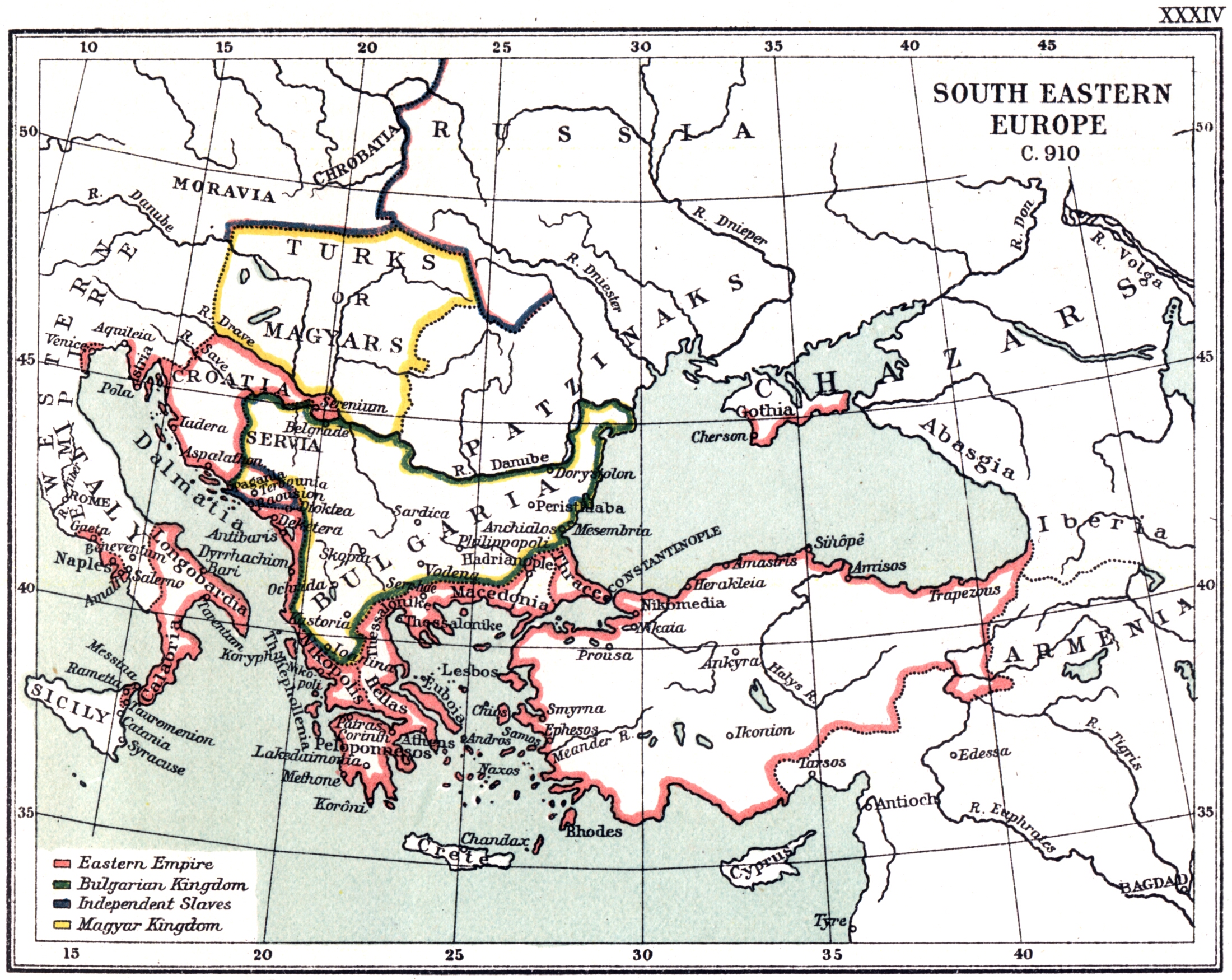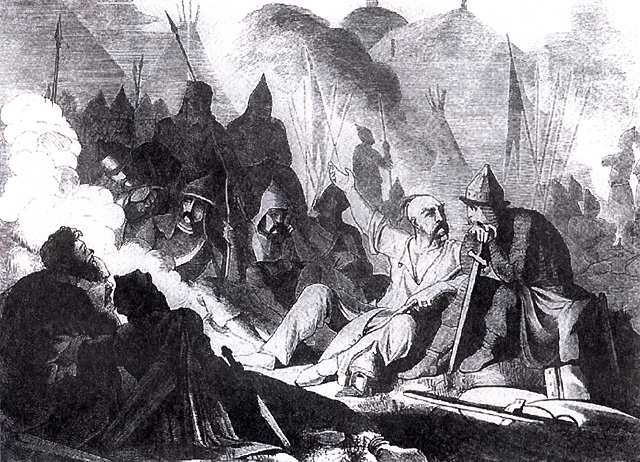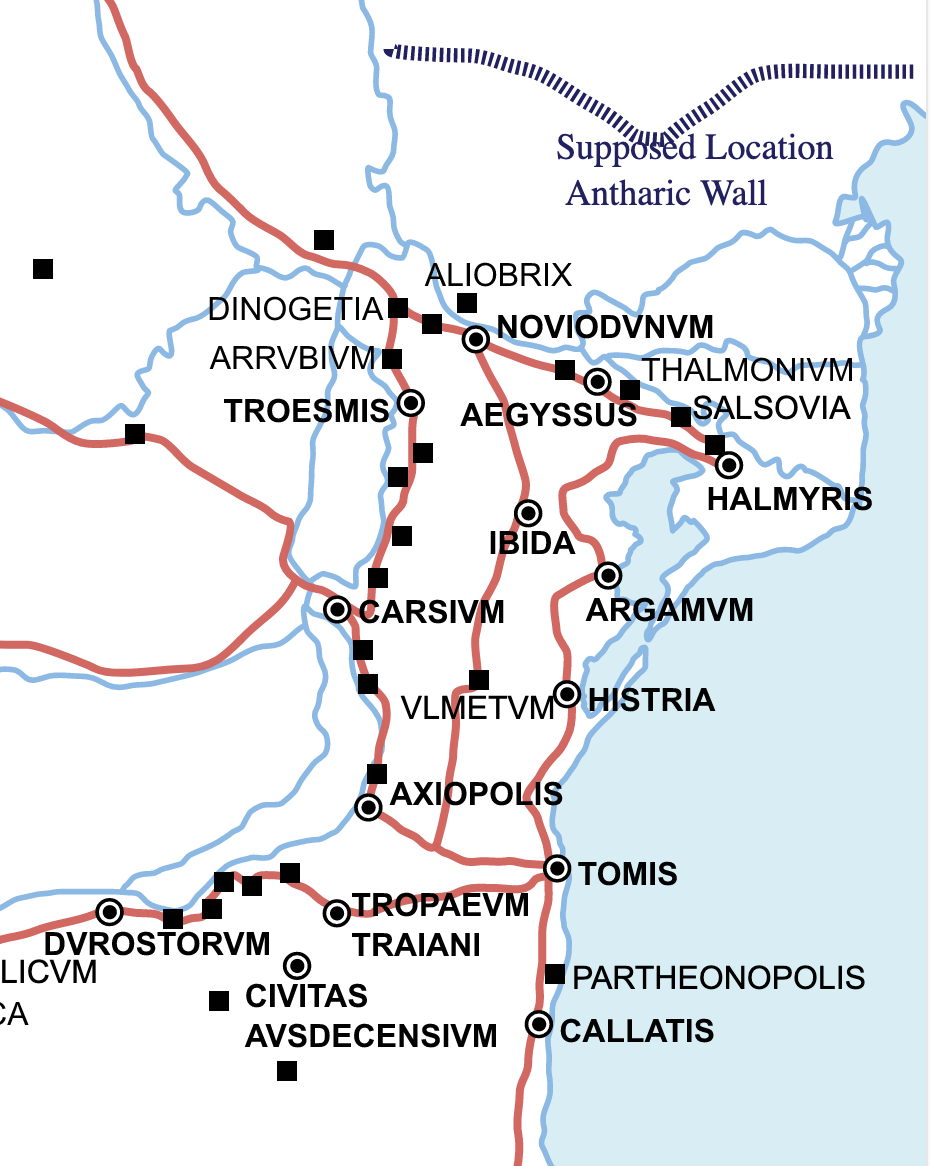|
Pereyaslavets
Pereyaslavets ( East Slavic: ) or Preslavets () was a trade city located near mouths of the Danube. The city's name is derived from that of the Bulgarian capital of the time, Preslav, and means Little Preslav (). In Greek it was also known as Presthlavitza (). Several theories exist regarding the exact location of the city: either at Preslav or in its vicinity in Bulgaria, or at Isaccea, Nufăru, Murighiol or Jurilovca in Romania. A thriving trade centre of the First Bulgarian Empire, it was captured by Prince Svyatoslav of Kievan Rus in 968 (See Sviatoslav's invasion of Bulgaria). During Svyatoslav's absence from the city following the Siege of Kiev (968), part of the citizens revolted and opened the gate to Bulgarian forces. According to Vasily Tatischev, Svyatoslav's governor Volk managed to escape. Upon his return to Bulgaria, Svyatoslav promptly suppressed the rebellion and, to the chagrin of his mother and relatives, transferred the capital from Kiev to Pereyaslavets ... [...More Info...] [...Related Items...] OR: [Wikipedia] [Google] [Baidu] |
Sviatoslav's Invasion Of Bulgaria
Sviatoslav's invasion of Bulgaria was a conflict beginning in 967/968 and ending in 971, carried out in the eastern Balkans, and involving the Kievan Rus', Bulgaria, and the Byzantine Empire. The Byzantines encouraged the Rus' ruler Sviatoslav to attack Bulgaria, leading to the defeat of the Bulgarian forces and the occupation of the northern and north-eastern part of the country by the Rus' for the following two years. The allies then turned against each other, and the ensuing military confrontation ended with a Byzantine victory. The Rus' withdrew and eastern Bulgaria was incorporated into the Byzantine Empire. In 927, a peace treaty had been signed between Bulgaria and Byzantium, ending many years of warfare and establishing forty years of peace. Both states prospered during this interlude, but the balance of power gradually shifted in favour of the Byzantines, who made great territorial gains against the Abbasid Caliphate in the east and formed a web of alliances surrounding Bu ... [...More Info...] [...Related Items...] OR: [Wikipedia] [Google] [Baidu] |
Sviatoslav I Of Kiev
Sviatoslav or Svyatoslav I Igorevich (; Old Norse: ''Sveinald''; – 972) was Prince of Kiev from 945 until his death in 972. He is known for his persistent campaigns in the east and south, which precipitated the collapse of two great powers in Eastern Europe, Khazaria and the First Bulgarian Empire. He conquered numerous East Slavic tribes, defeated the Alans and attacked the Volga Bulgars, and at times was allied with the Pechenegs and Magyars (Hungarians). Following the death of his father Igor in 945, Sviatoslav's mother Olga reigned as regent in Kiev until 962. His decade-long reign over the Kievan Rus' was marked by rapid expansion into the Volga River valley, the Pontic steppe, and the Balkans, leading him to carve out for himself the largest state in Europe. In 969, he moved his seat to Pereyaslavets on the Danube. In 970, he appointed his sons Yaropolk and Oleg as subordinate princes of Kiev and Drelinia, while he appointed Vladimir, his son by his housekeeper ... [...More Info...] [...Related Items...] OR: [Wikipedia] [Google] [Baidu] |
First Bulgarian Empire
The First Bulgarian Empire (; was a medieval state that existed in Southeastern Europe between the 7th and 11th centuries AD. It was founded in 680–681 after part of the Bulgars, led by Asparuh of Bulgaria, Asparuh, moved south to the northeastern Balkans. There they secured Byzantine Empire, Byzantine recognition of their right to settle south of the Danube by Battle of Ongal, defeatingpossibly with the help of Seven Slavic tribes, local South Slavic tribesthe Byzantine army led by Constantine IV. During the 9th and 10th century, Bulgaria at the height of its power spread from the Danube Bend to the Black Sea and from the Dnieper River to the Adriatic Sea and became an important power in the region competing with the Byzantine Empire. As the state solidified its position in the Balkans, it entered into a centuries-long interaction, sometimes friendly and sometimes hostile, with the Byzantine Empire. Bulgaria emerged as Byzantium's chief antagonist to its north, resulting in ... [...More Info...] [...Related Items...] OR: [Wikipedia] [Google] [Baidu] |
Siege Of Kiev (968)
The siege of Kiev by the Pechenegs in 968 (''sub anno'' 6476) is narrated in pages 65.19–67.20 of the ''Primary Chronicle''. It is an account that freely mixes historical details with folklore. Sviatoslav ultimately repelled the Pecheneg invasion and the Siege was a failure for the Pechenegs. Narrative According to the chronicle, while Sviatoslav I was pursuing his campaign against the First Bulgarian Empire, the Pechenegs (in all probability, bribed by Byzantine Emperor Nicephorus Phocas) invaded Rus and besieged his capital of Kiev (Kyiv). While the besieged suffered from hunger and thirst, Sviatoslav's general Pretich deployed his ''druzhina'', his personal guard, on the opposite (left) bank of the Dnieper, not daring to cross the river against the larger Pecheneg force. Reduced to extremes, Sviatoslav's mother Olga of Kiev (who was in Kiev together with all of Sviatoslav's sons) contemplated surrender if Pretich did not relieve the siege within one day. She was an ... [...More Info...] [...Related Items...] OR: [Wikipedia] [Google] [Baidu] |
Nufăru
Nufăru is a commune in Tulcea County, Northern Dobruja, Romania, thought to be the short-lived ancient capital of Kievan Rus, Pereyaslavets Pereyaslavets ( East Slavic: ) or Preslavets () was a trade city located near mouths of the Danube. The city's name is derived from that of the Bulgarian capital of the time, Preslav, and means Little Preslav (). In Greek it was also known as Pr ..., and called ''Prislav'' until 1968. It is composed of four villages: Ilganii de Jos, Malcoci, Nufăru and Victoria (formerly ''Pârlita''). References * Communes in Tulcea County Localities in Northern Dobruja {{Tulcea-geo-stub ... [...More Info...] [...Related Items...] OR: [Wikipedia] [Google] [Baidu] |
Kievan Rus
Kievan Rus', also known as Kyivan Rus,. * was the first East Slavic state and later an amalgam of principalities in Eastern Europe from the late 9th to the mid-13th century.John Channon & Robert Hudson, ''Penguin Historical Atlas of Russia'' (Penguin, 1995), p.14–16. Encompassing a variety of polities and peoples, including East Slavic, Norse, and Finnic, it was ruled by the Rurik dynasty, founded by the Varangian prince Rurik.Kievan Rus , Encyclopædia Britannica Online. The name was coined by Russian historians in the 19th century to describe the period when was preeminent. At its greatest extent in the mid-11th century, Kievan Rus' stretched from the |
Strategos
''Strategos'' (), also known by its Linguistic Latinisation, Latinized form ''strategus'', is a Greek language, Greek term to mean 'military General officer, general'. In the Hellenistic world and in the Byzantine Empire, the term was also used to describe a military governor. In the modern Hellenic Army, it is the highest officer rank. Etymology ''Strategos'' is a compound of two Greek words: ''stratos'' and ''agos''. ''Stratos'' (στρατός) means 'army', literally 'that which is spread out', coming from the proto-Indo-European root *stere-, 'to spread'. ''Agos'' (ἀγός) means 'leader', from ''agein'' (ἄγειν), 'to lead', from the pelasgic root *ag-, 'to drive, draw out or forth, move'. Classical Greece Athens In its most famous attestation, in Classical Athens, the office of ''strategos'' existed already in the 6th century BC, but it was only with the reforms of Cleisthenes in 501 BC that it assumed its most recognizable form: Cleisthenes instituted a boa ... [...More Info...] [...Related Items...] OR: [Wikipedia] [Google] [Baidu] |
Medieval Dobruja
In the history of Europe, the Middle Ages or medieval period lasted approximately from the 5th to the late 15th centuries, similarly to the post-classical period of World history (field), global history. It began with the fall of the Western Roman Empire and transitioned into the Renaissance and the Age of Discovery. The Middle Ages is the middle period of the three traditional divisions of Western history: classical antiquity, the medieval period, and the modern period. The medieval period is itself subdivided into the Early Middle Ages, Early, High Middle Ages, High, and Late Middle Ages. Population decline, counterurbanisation, the collapse of centralised authority, invasions, and mass migrations of tribes, which had begun in late antiquity, continued into the Early Middle Ages. The large-scale movements of the Migration Period, including various Germanic peoples, formed new kingdoms in what remained of the Western Roman Empire. In the 7th century, North Africa and the ... [...More Info...] [...Related Items...] OR: [Wikipedia] [Google] [Baidu] |
Rus'–Byzantine Treaty (911)
The Rus'–Byzantine Treaty of 911 is the most comprehensive and detailed treaty which was allegedly concluded between the Byzantine Empire and Kievan Rus' in the early 10th century. It was preceded by the preliminary treaty of 907. It is considered the earliest written source of Kievan Rus' law. The text of this treaty is only found in the ''Primary Chronicle'' (PVL), and its authenticity is therefore difficult to establish. Contents The text of the document is incorporated into the ''Primary Chronicle'' (PVL) '' sub anno'' 911. The text also includes speeches of the parties on the occasion. * The treaty opens with a lengthy enumeration of the Rus' envoys. * Article 1 proclaims the "solid and durable" friendship between Rus' and Greeks, and provides that the Rus' will never cause any damage to the Greeks and vice-versa. * The articles 3 to 7 regulate criminal law and the life of their colony at Constantinople. There is also a proviso on inheritance of a merchant who died ... [...More Info...] [...Related Items...] OR: [Wikipedia] [Google] [Baidu] |
Pereiaslav
Pereiaslav is a historical town in Boryspil Raion, Kyiv Oblast, central Ukraine. It is located near the confluence of the Alta and Trubizh rivers some southeast of the capital Kyiv. It was one of the key regional centers of power during the Middle Ages and served as the capital of a principality. Pereiaslav hosts the administration of Pereiaslav urban hromada, one of the hromadas of Ukraine. Its population is approximately Possessing more than 20 museums, Pereiaslav is often described as a "living museum","Pereyaslav Khmelnytsky – a town of museums", ''Welcome to Ukraine'' magazine, March 2007 and was granted the status of . Etymology Current name The current name is implemented by the Verkhovna Rada on 30 September 2019 to reinstate its historical name. The name of Pereiaslav in other languages are: * , (also rendered as Pereyaslav) * * * * * Former names * Pereiaslav (907 – 1943; also known as Pereiaslav-Ruskyi starting from 1152) * Pereiaslav-Khmelnyt ... [...More Info...] [...Related Items...] OR: [Wikipedia] [Google] [Baidu] |
Tulcea
Tulcea (; also known by #Names, alternative names) is a city in Northern Dobruja, Romania. It is the administrative center of Tulcea County, and had a population of 65,624 . One village, Tudor Vladimirescu, is administered by the city. It is one of six Romanian county seats List of cities and towns on the river Danube, lying on the river Danube. Names The city is known in Bulgarian, Russian and Ukrainian as Тулча, Romanization of Cyrillic, romanized: ''Tulcha''; in Greek as Αιγισσός, Romanization of Greek, romanized: ''Aigissós''; in Hungarian as ''Tulcsa''; and in Turkish as ''Tulça''. History Iron Age Tulcea was founded in the 7th century BC under the name of ''Aegyssus'', mentioned by Procopius. Ovid recorded a local tradition that ascribed its name to a mythical founder, Aegisos the Caspian. Roman period Aegyssus was built on a high hill, a strategic location for guarding the Danube particularly under the Romans. The amphorae discovered from 1st century ... [...More Info...] [...Related Items...] OR: [Wikipedia] [Google] [Baidu] |
Sfântu Gheorghe Branch
The Sfântu Gheorghe branch (; ) is a distributary of the river Danube, that contributes in forming the Danube Delta. This is the southernmost branch of the Danube; the other two main branches are the Chilia branch and the Sulina branch The Sulina branch is a distributary of the river Danube that contributes to forming the Danube Delta. The other two main branches of the Danube are the Chilia branch to the north and the Sfântu Gheorghe branch to the south. The Sulina bra .... The Sfântu Gheorghe branch runs on a length of , in a southeasterly direction. Its outflow comprises about 22% of the Danube's discharge. Distributaries of the Danube {{Tulcea-river-stub ... [...More Info...] [...Related Items...] OR: [Wikipedia] [Google] [Baidu] |





